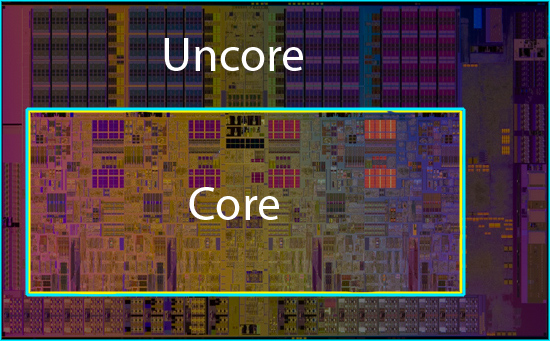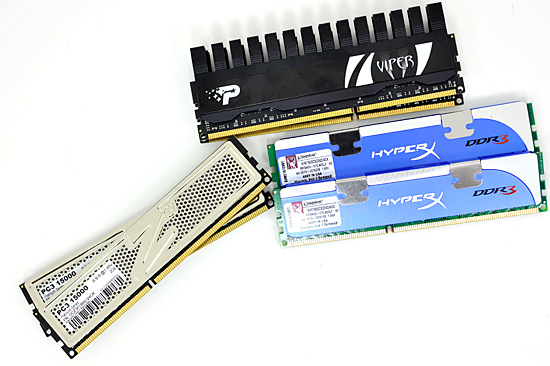Intel's Core i7 870 & i5 750, Lynnfield: Harder, Better, Faster Stronger
by Anand Lal Shimpi on September 8, 2009 12:00 AM EST- Posted in
- CPUs
Lynnfield's Un-Core: Faster Than Most Bloomfields
A few years ago I had a bet going with AMD's Ian McNaughton. We were at an AMD event where the Phenom architecture was first being introduced and he insisted that the L3 cache was part of the memory controller. This didn't make any sense to me so I disagreed. Minutes later a presentation slide went up on a projector talking about how the L3 cache and memory controller were on the same voltage plane; that's what he meant. Ian laughed a lot and to this day he holds it over my head.
The moral of the story is in Phenom and later in Nehalem, the processor is divided into two parts. Intel named them the core and the un-core. The "core" of these multi-core processors is made up of each individual processor core and its associated private caches (L1/L2). The "uncore" refers to everything else: PCIe controller, memory controller, DMI/QPI and the L3 cache.

The uncore isn't as critical for performance but is made up of a ton of transistors; roughly 400 million in the case of Lynnfield/Bloomfield (more if you count the PCIe controller). In order to save power, Intel uses slower transistors that have lower leakage for the un-core. As a result, the un-core can't clock up as high as the core and runs at a lower multiplier.
Take the Bloomfield Core i7 975 for example. The core runs at 25x BCLK (25 x 133MHz = 3.33GHz), but the un-core runs at 20x BCLK (20 x 133MHz = 2.66GHz). The rest of the chips, including Lynnfield, have slower un-cores:
| CPU | Socket | Core Clock | Un-Core Clock |
| Intel Core i7 975 Extreme | LGA-1366 | 3.33GHz | 2.66GHz |
| Intel Core i7 965 Extreme | LGA-1366 | 3.20GHz | 2.66GHz |
| Intel Core i7 950 | LGA-1366 | 3.06GHz | 2.13GHz |
| Intel Core i7 940 | LGA-1366 | 2.93GHz | 2.13GHz |
| Intel Core i7 920 | LGA-1366 | 2.66GHz | 2.13GHz |
| Intel Core i7 870 | LGA-1156 | 2.93GHz | 2.40GHz |
| Intel Core i7 860 | LGA-1156 | 2.80GHz | 2.40GHz |
| Intel Core i5 750 | LGA-1156 | 2.66GHz | 2.13GHz |
Here's another area where Lynnfield is better than the lower end Bloomfields: its uncore runs at 2.40GHz instead of 2.13GHz. The exception being the Core i5 750, its uncore is stuck at 2.13GHz as well. Once again, only the "Extreme" Bloomfields have a faster uncore.
Lynnfield's Memory Controller: Also Faster than Bloomfield
Intel only officially supports two memory speeds on Bloomfield: DDR3-800 and DDR3-1066. Obviously we're able to run it much faster than that, but this is what's officially validated and supported on the processors.
Lynnfield is a year newer and thus gets a tweaked memory controller. The result? Official DDR3-1333 support.

Three Lynnfield memory kits (left to right): OCZ, Patriot and Kingston
The same sort of rules apply to Lynnfield memory kits that we saw with Bloomfield. You don't want to go above 1.65V and thus all the kits we've seen run at 1.5V for the stock JEDEC speeds or 1.65V for the overclocked modules.

Like Bloomfield, 1.65V is the max we'll see on Lynnfield










343 Comments
View All Comments
mschira - Tuesday, September 8, 2009 - link
I wonder if a 4xPCIe RAID adapter directly connected to a PCIe slot that is connected to the CPU is any faster than it is for a Core i7 920....Cheers
Gary Key - Tuesday, September 8, 2009 - link
Less than a one percent difference in my testing so far.Jamahl - Tuesday, September 8, 2009 - link
Why do your benches falsely state 2.66ghz when they are clearly running faster than that?rbbot - Tuesday, September 8, 2009 - link
lol - I've just been berating a reviewer on another site for benchmarking with turbo off! In that case the review wasn't targeted at an overclocking audience, but even here I can't see the argument for benchmarking with it disabled.Yes you do need to turn it off for extreme overclocking, but this review is comparing the chips in their stock configuration and stock configuration is on.
maxxcool - Tuesday, September 8, 2009 - link
As for false, well gee, you were told it was on. Didn't you read that? or are you snakeoils brother?goinginstyle - Tuesday, September 8, 2009 - link
They list the base CPU speeds, it was discussed clearly in the article that turbo is enabled, it is not a false statement for reporting what you will purchase. Apparently you just want to flame bait here and I hope they ban you and the two other nut jobs.rgallant - Wednesday, September 9, 2009 - link
people see what they want to see I guess-I wanted to see the multi gpu test, 1156 vs 1366 , clock vs clock ,fps vs fps ,16x vs 8x on die , not one chip overclocking it's self unless you show the numbers for turbo on and off, what if the 1366 mb used for the benches came out of the box and by the default bios overclocked the i7 920 to 3.8 ,would those numbers be included as stock out of the box. I don't think so , that feature would be turned off on the mb.for the benches. 1156 numbers could mean nothing really.
-all cpu's should been locked at 3.6 at least for the multi gpu test or one test anyways.
-the 8x 8x lane issue is the only crippled feature on the new chips ,and it seems to take a back seat to the $50.00 savings for a mb for a $600.00 i7 870 chip ,or $900.00 CND .lol On sept.05 my local shop had the i7 920 D0 and the i7 860 both at $345 CND.
-good review as always ,just missing that part for me , looking to commit on a 1156 or a 1366 upgrade.
maxxcool - Tuesday, September 8, 2009 - link
Yeah, you got to get rid of snakeoil, he is quiet the troll on the TechReport forums as well. He has been banned from several sites already.andrenb91 - Tuesday, September 8, 2009 - link
i5 is faster than PII's! but gotta wait for the lower end ones come outbecause these $190+ chips aren't the one ones that brings up revenue for companies like amd or intel...of course intel has the upper hand here, it could use as a propaganda do deliver up the slower parts. Amd has value and some good cpus at the lower end... that ones bring profits to the company,amd strategy is looking good for now, but it's design must change (native dual/tripe core versions of Phenom II) and the die size have to get smaller to compete next year (against 32nm low end ones...) well I use amd budget ones, for what I do is good enough, ( thin about $400 pc in USA, live in Brazil...) still, I can play some 40fps games and do some video encoding with my gpu,my point is, amd still have the lower-end market, the problem is, if were some of that people that think pentium is a company name, I would by the pentium cpus instead of amd strange cpus. that's why intel sells a lot more desktops and notebooks, of course the performace is great at some 700+ pcs and laptops, but amd has the lower-end, and there it is what amd is looking for: market share, and taht will pump amd back again by 2011 with its fusion apu, intel already controls 80% of mainstream,and high-end markets, but doesn't have a player for the lower-end, thats what I'm looking for a good old intel cpu that beats p2x3 or athlonIIx4 by intel at about $100. then I'll buy my next cpu, probably an intel, or continue with Amd, time will tell...
andrenb91 - Tuesday, September 8, 2009 - link
sorry for my english and, these benchmarks are for windows only, over linux intel i5 will not have this crazy advantage at all, well but who of us uses linux anyway?(don't lie to me, it's a dual boot...) well my system specs are: phenomII x3 705e,4gb ddr3 1333,hd 4650 basicaly a low-end to mainstream..